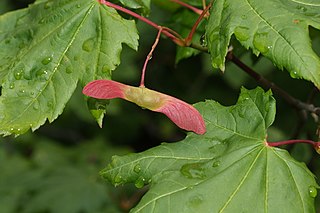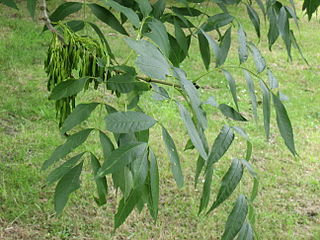
A samara is a winged achene, a type of fruit in which a flattened wing of fibrous, papery tissue develops from the ovary wall. A samara is a simple dry fruit and indehiscent. The shape of a samara enables the wind to carry the seed farther away than regular seeds from the parent tree, and is thus a form of anemochory.

Fraxinus, English name ash, is a genus of flowering plants in the olive and lilac family, Oleaceae. It contains 45–65 species of usually medium to large trees, mostly deciduous, though a number of subtropical species are evergreen. The genus is widespread across much of Europe, Asia, and North America.

Fraxinus americana, the white ash or American ash, is a species of ash tree native to eastern and central North America. It is found in mesophytic hardwood forests from Nova Scotia west to Minnesota, south to northern Florida, and southwest to eastern Texas. Isolated populations have also been found in western Texas, Wyoming, and Colorado, and the species is reportedly naturalized in Hawaii.

Fraxinus excelsior, known as the ash, or European ash or common ash to distinguish it from other types of ash, is a flowering plant species in the olive family Oleaceae. It is native throughout mainland Europe east to the Caucasus and Alborz mountains, and the British Isles which determine its western boundary. The northernmost location is in the Trondheimsfjord region of Norway. The species is widely cultivated and reportedly naturalised in New Zealand and in scattered locales in the United States and Canada.

The genus Pulsatilla contains about 40 species of herbaceous perennials native to meadows and prairies of North America, Europe, and Asia. Derived from the Hebrew word for Passover, "pasakh", the common name pasque flower, refers to the Easter (Passover) flowering period, in the spring. Common names include pasque flower, wind flower, prairie crocus, Easter flower, and meadow anemone. Several species are valued ornamentals because of their finely-dissected leaves, solitary bell-shaped flowers, and plumed seed heads. The showy part of the flower consists of sepals, not petals.

Alexander Georg von Bunge was a Russian botanist. He is best remembered for scientific expeditions into Asia and especially Siberia.

Pinus bungeana is a pine tree native to northeastern and central China. It is a slow-growing tree that can grow to heights of 15–25m and is frost hardy down to below -26 °C. Its smooth, grey-green bark gradually sheds in round scales to reveal patches of pale yellow, which turn olive-brown, red and purple on exposure to light.
The University of Delaware Botanic Gardens are botanical gardens and an arboretum located on the campus of the University of Delaware, in Newark, Delaware, United States. The gardens are open to the public without charge.

Fraxinus pennsylvanica, the green ash or red ash, is a species of ash native to eastern and central North America, from Nova Scotia west to southeastern Alberta and eastern Colorado, south to northern Florida, and southwest to Oklahoma and eastern Texas. It has spread and become naturalized in much of the western United States and also in Europe from Spain to Russia.

Fraxinus angustifolia, the narrow-leafed ash, is a species of Fraxinus native to central and southern Europe, northwest Africa, and southwest Asia.

Fraxinus lanuginosa is a species of ash native to Japan and to the Primorye region of eastern Russia.

Fraxinus floribunda is a species of ash native to South Asia, East Asia, and Southeast Asia. It is known from Afghanistan, Pakistan, Nepal, Assam, Bhutan, Laos, Myanmar (Burma), Thailand, Vietnam, the Ryukyu Islands, and parts of China.

Aceria fraxinivora, also known as the cauliflower gall mite and the ash key gall, causes the growths, known as galls, found on the hanging seeds or "keys" of the ash (Fraxinus species.
Fraxinus berlandieriana, the Mexican ash, is a tree native to eastern and northeastern Mexico and to the south-central United States. It has been reported from Tamaulipas, Veracruz, Texas, New Mexico, Oklahoma, Louisiana and Mississippi.
Persicaria bungeana is a herbaceous annual, flowering plant species in the family Polygonaceae. Commonly known as prickly smartweed or Bunge's smartweed, it is a weed found in soybean fields of the Mid-Western United States of America.

Fraxinus uhdei, commonly known as tropical ash or Shamel ash, is a species of tree native to Mexico and Central America. It is commonly planted as a street tree in Mexico and the southwestern United States. It has also been planted and spread from cultivation in Hawaii, where it is now considered an invasive species.
Dasineura acrophila is a gall midge which forms galls on the leaves of ash. It was first described by Johannes Winnertz in 1853 an is found in Europe.
Fraxinus pallisiae is a species of flowering plant belonging to the family Oleaceae.
Girgensohnia bungeana is a species of flowering plant belonging to the family Amaranthaceae.
Pulsatilla bungeana is a species of flowering plant belonging to the family Ranunculaceae.












